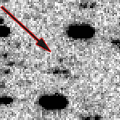
|
It will approach to Sun down to 0.1 a.u. on Jan. 31. In the Northern Hemisphere, it will appear in the morning sky at 9 mag in mid February, then it stays observable while the comet will be fading. In the Southern Hemisphere, it stays observable for a long time, although it is not observable from mid January to mid February.
Date(TT) R.A. (2000) Decl. Delta r Elong. m1 Best Time(A, h)
Jan. 21 21 0.68 -33 56.0 1.227 0.418 17 8.6 18:45 ( 60,-16)
Jan. 28 21 19.18 -24 10.8 0.977 0.186 10 3.9 18:51 ( 71,-13)
|
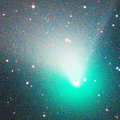
|
Now it is very bright as 6.0 mag (Jan. 19, Virgilio Gonano). It will approach to Earth down to 0.29 a.u. in February, and it brightens up to 5 mag. In the Northern Hemisphere, it stays observable in excellent condition for a long time. In the Southern Hemisphere, it is not observable until early February.
Date(TT) R.A. (2000) Decl. Delta r Elong. m1 Best Time(A, h)
Jan. 21 15 32.70 51 13.9 0.479 1.120 93 5.9 5:37 (224, 64)
Jan. 28 13 59.07 73 53.6 0.325 1.139 110 5.1 5:34 (180, 52)
|

|
Now it is very bright as 8.0 mag (Jan. 15, Marco Goiato). It is observable at 8 mag for a long time from 2022 to 2023. In the Southern Hemisphere, it stays observable for a long time, although it became low temporarily from November to December. In the Northern Hemisphere, it is not observable until summer.
Date(TT) R.A. (2000) Decl. Delta r Elong. m1 Best Time(A, h)
Jan. 21 21 7.00 -70 30.4 2.295 1.844 51 7.8 18:45 ( 23,-31)
Jan. 28 22 12.35 -70 45.2 2.263 1.866 54 7.8 18:51 ( 21,-28)
|
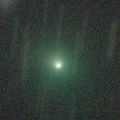
|
It brightened very rapidly. Now it is very bright as 9.9 mag (Jan. 16, Osamu Miyazaki). It stays 9-10 mag until March. In the Northern Hemisphere, it will be observable in good condition after this. In the Southern Hemisphere, it is not observable until June.
Date(TT) R.A. (2000) Decl. Delta r Elong. m1 Best Time(A, h)
Jan. 21 18 3.59 57 43.4 1.617 1.774 82 9.5 5:37 (221, 41)
Jan. 28 19 5.63 58 42.5 1.646 1.757 79 9.5 5:34 (219, 37)
|
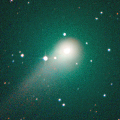
|
Now it is 10.6 mag (Jan. 20, Osamu Miyazaki). It stays bright as 10 mag for a long time until autumn. In the Northern Hemisphere, it stays observable in good condition until autumn. In the Southern Hemipshere, it stays unobservable until summer.
Date(TT) R.A. (2000) Decl. Delta r Elong. m1 Best Time(A, h)
Jan. 21 1 28.53 64 46.5 2.122 2.543 103 9.7 18:45 (164, 58)
Jan. 28 1 28.44 59 34.0 2.184 2.506 97 9.7 18:51 (152, 60)
|
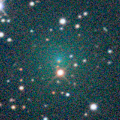
|
It brightened very rapidly. Now it is very bright as 11.5 mag (Jan. 10, Katsumi Yoshimoto). It stays 11-12 mag until February. In the Northern Hemisphere, it stays observable in excellent condition. In the Southern Hemisphere, it is not observable until February.
Date(TT) R.A. (2000) Decl. Delta r Elong. m1 Best Time(A, h)
Jan. 21 3 12.33 68 55.7 0.580 1.332 114 11.3 19:17 (180, 57)
Jan. 28 4 13.43 58 40.8 0.564 1.344 117 11.3 19:48 (180, 67)
|

|
It brightened up to 8.3 mag in last winter (Jan. 6, 2022, Toshiyuki Takahashi). Now it is fading. But it is bright as 11.1 mag still now (Jan. 2, Osamu Miyazaki).
Date(TT) R.A. (2000) Decl. Delta r Elong. m1 Best Time(A, h)
Jan. 21 9 45.04 -33 27.8 4.279 4.871 121 11.5 1:46 ( 0, 21)
Jan. 28 9 40.32 -34 9.0 4.274 4.911 125 11.5 1:14 ( 0, 21)
|
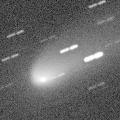
|
Now it is 11.6 mag (Jan. 20, Osamu Miyazaki). It stays 11-12 mag until spring.
Date(TT) R.A. (2000) Decl. Delta r Elong. m1 Best Time(A, h)
Jan. 21 15 25.34 -15 53.7 1.743 1.639 67 11.6 5:37 (328, 33)
Jan. 28 15 43.15 -16 45.2 1.707 1.655 70 11.7 5:34 (331, 33)
|

|
Now it is 13.2 mag (Nov. 27, Ken-ichi Kadota). It is expected to brighten up to 11 mag in 2023. In the Southern Hemisphere, it stays observable in good condition for a long time, although it becomes unobservable temporarily from November to January. In the Northern Hemisphere, it is not observable until 2024 autumn.
Date(TT) R.A. (2000) Decl. Delta r Elong. m1 Best Time(A, h)
Jan. 21 18 47.11 -28 31.6 4.152 3.250 20 11.7 5:37 (300, -7)
Jan. 28 18 55.12 -29 43.2 4.081 3.228 26 11.7 5:34 (303, -5)
|
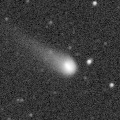
|
Now it is 12.4 mag (Dec. 23, Jose Guilherme de S. Aguiar). It stays 12 mag until summer. It stays observable in good condition for a long time.
Date(TT) R.A. (2000) Decl. Delta r Elong. m1 Best Time(A, h)
Jan. 21 13 43.49 2 2.6 3.424 3.676 96 12.4 5:37 (357, 57)
Jan. 28 13 38.37 1 32.4 3.285 3.666 104 12.3 5:12 ( 0, 56)
|
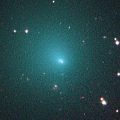
|
Now it is bright as 11.4 mag (Dec. 14, Jose Guilherme de S. Aguiar). It will be fading after this. In the Southern Hemisphere, it becomes unobservable temporarily from December to January. In the Northern Hemisphere, it is not observable until spring when it fades down to 15 mag.
Date(TT) R.A. (2000) Decl. Delta r Elong. m1 Best Time(A, h)
Jan. 21 19 26.26 -38 6.9 2.626 1.738 20 12.3 5:37 (304,-19)
Jan. 28 19 25.63 -38 14.9 2.612 1.775 25 12.6 5:34 (307,-15)
|
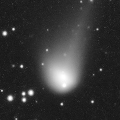
|
Now it is bright as 12.9 mag (Jan. 2, Hiroshi Abe). It stays 13 mag until spring. It stays observable in good condition for a while after this. It will be getting higher rapidly also in the Southern Hemisphere.
Date(TT) R.A. (2000) Decl. Delta r Elong. m1 Best Time(A, h)
Jan. 21 15 22.76 1 17.7 4.818 4.635 73 12.9 5:37 (318, 48)
Jan. 28 15 27.55 2 9.0 4.740 4.659 79 12.9 5:34 (324, 51)
|
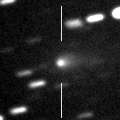
|
Now it is 12.8 mag (Jan. 10, Masayoshi Yoshimi). It stays bright as 13 mag and observable in excellent condition until February.
Date(TT) R.A. (2000) Decl. Delta r Elong. m1 Best Time(A, h)
Jan. 21 8 36.70 11 54.6 0.917 1.894 169 13.0 0:39 ( 0, 67)
Jan. 28 8 32.69 13 17.7 0.927 1.910 174 13.1 0:07 ( 0, 68)
|
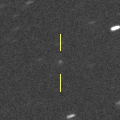
|
It brightens up to 13 mag in winter. But the condition is bad. It is not observable until February in the Southern Hemisphere, or until May in the Northern Hemisphere.
Date(TT) R.A. (2000) Decl. Delta r Elong. m1 Best Time(A, h)
Jan. 21 18 43.19 -25 54.7 2.470 1.589 20 13.3 5:37 (299, -5)
Jan. 28 19 6.72 -25 49.2 2.452 1.589 22 13.3 5:34 (299, -4)
|
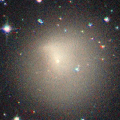
|
It brightened in major outburst in late November. Now it is bright as 11.6 mag (Jan. 18, Toshihiko Ikemura, Hirohisa Sato).
Date(TT) R.A. (2000) Decl. Delta r Elong. m1 Best Time(A, h)
Jan. 21 6 26.68 29 17.2 5.159 6.064 154 13.4 22:25 ( 0, 84)
Jan. 28 6 23.64 29 10.8 5.214 6.066 147 13.5 21:54 ( 0, 84)
|
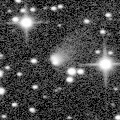
|
Now it is 13.9 mag (Jan. 13, P. Lindner). The brightness evolution is slower than originally predicted. It stays 14 mag until summer. In the Northern Hemisphere, it stays observable in good condition until spring. In the Southern Hemisphere, it stays observable in good condition for a long time.
Date(TT) R.A. (2000) Decl. Delta r Elong. m1 Best Time(A, h)
Jan. 21 3 17.69 -9 38.3 1.941 2.354 102 13.5 19:16 ( 0, 45)
Jan. 28 3 15.66 -11 17.6 2.013 2.314 94 13.6 18:51 ( 1, 44)
|
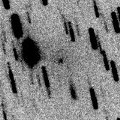
|
Tiny comet, but it will approach to Sun down to 0.8 a.u. in January, and to Earth down to 0.6 a.u. in March. It will brighten up to 14 mag from January to March. In the Southern Hemisphere, it stays observable in good condition for a long time. In the Northern Hemisphere, it is not observable now. It will become observable in early March. It has not been observed since late October.
Date(TT) R.A. (2000) Decl. Delta r Elong. m1 Best Time(A, h)
Jan. 21 22 5.86 -56 23.1 1.245 0.838 42 14.2 18:45 ( 33,-19)
Jan. 28 22 37.23 -59 41.5 1.135 0.847 46 14.1 18:51 ( 30,-21)
|
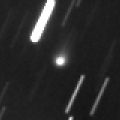
|
Now it is 14.7 mag (Jan. 13, ATLAS Chile). It stays 14 mag in 2023. In the Southern Hemisphere, it stays observable in good condition for a long time. It locates somewhat low in the Northern Hemisphere.
Date(TT) R.A. (2000) Decl. Delta r Elong. m1 Best Time(A, h)
Jan. 21 3 7.48 -18 12.9 3.197 3.450 96 14.4 19:05 ( 0, 37)
Jan. 28 2 58.75 -16 42.2 3.298 3.428 89 14.4 18:51 ( 7, 38)
|
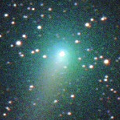
|
It brightened up to 9.3 mag in early summer (June 5, Chris Wyatt). Now it is fading. It has already faded down to 15.7 mag (Jan. 13, ATLAS South Africa). In the Southen Hemisphere, it stays observable in good condition for a long time. It became observable also in the Northern Hemisphere. But it stays locating low for a while.
Date(TT) R.A. (2000) Decl. Delta r Elong. m1 Best Time(A, h)
Jan. 21 7 47.56 -37 40.2 2.590 3.222 122 14.4 23:44 ( 0, 17)
Jan. 28 7 33.02 -35 14.5 2.631 3.285 124 14.6 23:02 ( 0, 20)
|
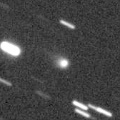
|
Now it is 14.8 mag (Jan. 4, iTelescope Observatory, Siding Spring). It is expected to brighten up to 8 mag in July. It will be getting lower after this. And it will be unobservable in February. In the Southern Hemisphere, it will be observable in excellent condition at the high light. In the Northern Hemisphere, it becomes very low at the high lihght.
Date(TT) R.A. (2000) Decl. Delta r Elong. m1 Best Time(A, h)
Jan. 21 0 25.46 -13 32.1 3.247 2.902 61 14.7 18:45 ( 41, 31)
Jan. 28 0 23.36 -13 19.3 3.299 2.832 53 14.6 18:51 ( 49, 26)
|
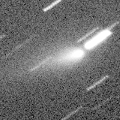
|
Outburst occured in early October, and it brightened up to 9.9 mag (Oct. 14, Thomas Lehmann). It is bright as 12.4 mag still now (Dec. 23, Ken-ichi Kadota). It stays observable only until February in the Southern Hemisphere, or until March in the Northern Hemisphere.
Date(TT) R.A. (2000) Decl. Delta r Elong. m1 Best Time(A, h)
Jan. 21 23 51.83 -8 59.3 2.485 2.075 54 14.9 18:45 ( 52, 30)
Jan. 28 0 4.95 -7 11.0 2.611 2.136 51 15.3 18:51 ( 57, 28)
|

|
Now it is 15.1 mag (Oct. 26, Thomas Lehmann). The brightness evolution is slower than originally expected. It stays 14-15 mag for a long time. Appearing in the morning sky in the Northern Hemisphere. It will appear in the morning sky in early February also in the Southern Hemisphere.
Date(TT) R.A. (2000) Decl. Delta r Elong. m1 Best Time(A, h)
Jan. 21 17 55.90 -8 25.4 3.976 3.213 34 15.0 5:37 (292, 15)
Jan. 28 17 59.52 -6 55.6 3.925 3.240 40 15.0 5:34 (294, 20)
|
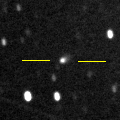
|
Now it is 15.2 mag (Jan. 6, ATLAS South Africa). It is expected to brighten up to 7 mag in early 2024. In the Southern Hemisphere, it stays observable in good condition for a long time. It locates low in the Northern Hemisphere.
Date(TT) R.A. (2000) Decl. Delta r Elong. m1 Best Time(A, h)
Jan. 21 5 27.37 -38 6.4 4.458 4.889 110 15.1 21:25 ( 0, 17)
Jan. 28 5 22.99 -37 38.2 4.436 4.823 107 15.1 20:53 ( 0, 17)
|

|
Appearing in the morning sky. Now it is 16.0 mag (Jan. 7, Ken-ichi Kadota). It will brighten very rapidly. It is expected to be observable at 11 mag in excellent condition from spring to summer.
Date(TT) R.A. (2000) Decl. Delta r Elong. m1 Best Time(A, h)
Jan. 21 16 19.57 -25 22.8 2.624 2.180 53 15.5 5:37 (322, 18)
Jan. 28 16 35.70 -25 33.4 2.539 2.158 56 15.1 5:34 (323, 19)
|
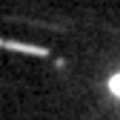
|
Now it is 16.1 mag (Jan. 12, Catalina Sky Survey). It will brighten rapidly up to 14 mag and will be observable in excellent condition in spring. In the Northern Hemisphere, it is observable in good condition in winter, but it becomes somewhat low in spring.
Date(TT) R.A. (2000) Decl. Delta r Elong. m1 Best Time(A, h)
Jan. 21 14 9.02 -10 15.7 2.242 2.397 86 15.2 5:37 (349, 44)
Jan. 28 14 15.84 -11 46.9 2.145 2.388 91 15.1 5:34 (355, 43)
|
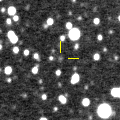
|
Now it is 15.7 mag (Dec. 31, iTelescope Observatory, Siding Spring). It will brighten up to 13 mag from 2024 to 2025. It is observable in excllent condition in the Southern Hemisphere. It locates low in the Northern Hemisphere.
Date(TT) R.A. (2000) Decl. Delta r Elong. m1 Best Time(A, h)
Jan. 21 9 5.44 -39 22.6 6.159 6.694 119 15.2 1:07 ( 0, 16)
Jan. 28 9 2.61 -39 28.9 6.089 6.661 121 15.1 0:37 ( 0, 15)
|

|
Now it is 14.8 mag (Dec. 8, ATLAS Chile). Now it is not observable. It will become observable again in late March in the Southern Hemisphere, or in late May in the Northern Hemisphere.
Date(TT) R.A. (2000) Decl. Delta r Elong. m1 Best Time(A, h)
Jan. 21 21 24.44 -22 15.3 4.115 3.190 17 15.1 18:45 ( 66, -5)
Jan. 28 21 35.33 -21 23.5 4.149 3.200 13 15.2 18:51 ( 70, -9)
|
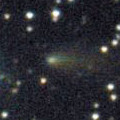
|
Now it is 14.3 mag (Jan. 3, Masayoshi Yoshimi). It will be fading after this, and it will be fainter than 18 mag in spring. It is observable in good condition in the Northern Hemisphere. It locates somewhat low in the Southern Hemisphere.
Date(TT) R.A. (2000) Decl. Delta r Elong. m1 Best Time(A, h)
Jan. 21 7 41.76 23 46.4 1.600 2.579 172 15.4 23:39 ( 0, 79)
Jan. 28 7 36.53 24 18.8 1.638 2.599 164 15.5 23:07 ( 0, 79)
|
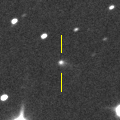
|
Now it is 15.2 mag (Jan. 13, ATLAS-HKO, Haleakala). It stays 15-16 mag and observable in good condition until spring.
Date(TT) R.A. (2000) Decl. Delta r Elong. m1 Best Time(A, h)
Jan. 21 9 35.08 22 51.3 2.433 3.374 160 15.7 1:37 ( 0, 78)
Jan. 28 9 33.24 23 52.5 2.407 3.372 166 15.7 1:07 ( 0, 79)
|

|
Now it is 15.5 mag (Jan. 13, ATLAS Chile). It was expected to brighten up to 13 mag in 2022 spring. But actually, it was fainter than originally expected. In the Southern Hemisphere, it stays observable in good condition for a long time. In the Northern Hemisphere, it stays extremely low for a while.
Date(TT) R.A. (2000) Decl. Delta r Elong. m1 Best Time(A, h)
Jan. 21 2 17.09 -33 42.9 3.793 3.757 80 15.8 18:45 ( 7, 21)
Jan. 28 2 14.69 -31 20.8 3.919 3.793 75 15.9 18:51 ( 15, 22)
|
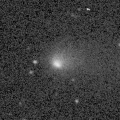
|
It brightened up to 14.6 mag in autumn (Oct. 19, Toshihiko Ikemura, Hirohisa Sato). Now it is fading. It has already faded down to 17.0 mag (Jan. 11, ATLAS Chile). It will be fainter than 18 mag in spring.
Date(TT) R.A. (2000) Decl. Delta r Elong. m1 Best Time(A, h)
Jan. 21 2 4.46 5 44.4 1.992 2.231 90 16.1 18:45 ( 20, 59)
Jan. 28 2 14.19 6 48.2 2.087 2.248 86 16.2 18:51 ( 32, 58)
|
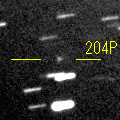
|
It brightened rapidly. Now it is 16.6 mag (Jan. 13, ATLAS-HKO, Haleakala). It is observable at 16 mag in good condition in winter.
Date(TT) R.A. (2000) Decl. Delta r Elong. m1 Best Time(A, h)
Jan. 21 10 18.40 16 41.5 1.008 1.922 149 16.1 2:20 ( 0, 72)
Jan. 28 10 16.45 17 39.4 0.996 1.941 156 16.1 1:50 ( 0, 72)
|
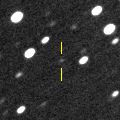
|
Now it is 16.0 mag (Jan. 10, ATLAS Chile). It is expected to brighten up to 12-13 mag from 2024 to 2025.
Date(TT) R.A. (2000) Decl. Delta r Elong. m1 Best Time(A, h)
Jan. 21 10 10.38 -19 19.6 5.588 6.276 130 16.2 2:12 ( 0, 36)
Jan. 28 10 4.76 -18 51.7 5.473 6.232 137 16.1 1:39 ( 0, 36)
|
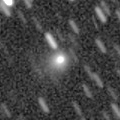
|
It brightened by 6 mag in outburst in early August up to 14.6 mag (Aug. 13, ATLAS-MLO, Mauna Loa). It has already faded down to 16.7 mag (Dec. 25, Catalina Sky Survey). It will be extremely low after this.
Date(TT) R.A. (2000) Decl. Delta r Elong. m1 Best Time(A, h)
Jan. 21 23 5.80 -6 55.8 2.279 1.722 44 16.1 18:45 ( 62, 24)
Jan. 28 23 24.93 -6 12.7 2.327 1.727 42 16.2 18:51 ( 66, 22)
|
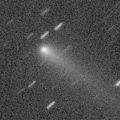
|
It brightened up to 14.1 mag in autumn (Nov. 14, Thomas Lehmann). Now it is fading. It has already faded down to 15.5 mag (Jan. 4, Ken-ichi Kadota). It stays observable in excellent condition for a while.
Date(TT) R.A. (2000) Decl. Delta r Elong. m1 Best Time(A, h)
Jan. 21 2 17.24 29 51.6 2.141 2.526 101 16.2 18:45 ( 52, 82)
Jan. 28 2 24.70 30 34.5 2.241 2.544 96 16.3 18:51 ( 73, 78)
|
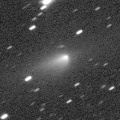
|
It brightened up to 12.7 mag in last year (Feb. 27, 2022, Jose Guilherme de S. Aguiar). Now it is fading. Appearing in the morning sky. In the Southern Hemisphere, it stays observable until summer when it becomes fainter than 18 mag. It locates low in the Northern Hemisphere.
Date(TT) R.A. (2000) Decl. Delta r Elong. m1 Best Time(A, h)
Jan. 21 17 45.67 -25 37.6 3.302 2.542 33 16.2 5:37 (307, 5)
Jan. 28 17 59.16 -25 45.6 3.272 2.565 37 16.3 5:34 (309, 7)
|

|
It was observed at 15 mag from 2021 to 2022. Now it is fading. In the Southern Hemisphere, it stays observable in excellent condition for a long time. In the Northern Hemiphere, it is not observable after this. It has not been observed since late September.
Date(TT) R.A. (2000) Decl. Delta r Elong. m1 Best Time(A, h)
Jan. 21 15 19.40 -62 54.0 6.379 6.019 64 16.3 5:37 (348,-10)
Jan. 28 15 18.88 -64 8.7 6.326 6.047 69 16.3 5:34 (351,-10)
|
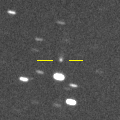
|
It will brighten up to 16 mag in 2023. In the Southern Hemisphere, it stays observable in good condition for a long time. In the Northern Hemisphere, it will never be observable again. It has not been observed since 2022 July.
Date(TT) R.A. (2000) Decl. Delta r Elong. m1 Best Time(A, h)
Jan. 21 15 29.17 -65 30.5 3.563 3.248 63 16.4 5:37 (348,-13)
Jan. 28 15 51.65 -67 7.2 3.516 3.245 66 16.3 5:34 (349,-14)
|
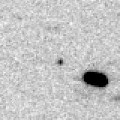
|
Now it is 16.6 mag (Jan. 13, ATLAS South Africa). It stays observable at 16 mag for a long time from early 2023 to early 2024. In the Northern Hemisphere, it is observable only until 2023 spring.
Date(TT) R.A. (2000) Decl. Delta r Elong. m1 Best Time(A, h)
Jan. 21 10 0.67 -2 3.1 3.468 4.311 145 16.5 2:02 ( 0, 53)
Jan. 28 9 52.23 -2 53.8 3.385 4.281 152 16.5 1:27 ( 0, 52)
|
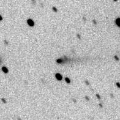
|
Now it is 16.5 mag (Jan. 1, Masayoshi Yoshimi). It is observable at 16-17 mag in excellent condition from autumn to winter.
Date(TT) R.A. (2000) Decl. Delta r Elong. m1 Best Time(A, h)
Jan. 21 4 0.80 -0 35.7 2.966 3.506 115 16.5 19:59 ( 0, 54)
Jan. 28 4 1.81 -0 6.5 3.058 3.511 109 16.6 19:33 ( 0, 55)
|
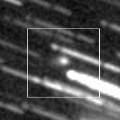
|
Now it is 17.2 mag (Dec. 12, D. Buczynski). It is expected to brighten up to 11.5 mag in 2024 spring. It stays observable in good condition for a long time. At the high light, it will be observable in excellent condition in the Southern Hemisphere, but it will be low in the Northern Hemisphere.
Date(TT) R.A. (2000) Decl. Delta r Elong. m1 Best Time(A, h)
Jan. 21 18 26.01 14 28.1 5.558 4.885 42 16.6 5:37 (268, 23)
Jan. 28 18 28.69 14 32.2 5.464 4.833 46 16.5 5:34 (271, 27)
|
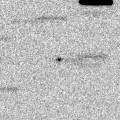
|
Now it is 17.0 mag (Jan. 7, Ken-ichi Kadota). It brightens rapidly, and it is observable at 16.5 mag in good condition from January to March.
Date(TT) R.A. (2000) Decl. Delta r Elong. m1 Best Time(A, h)
Jan. 21 11 40.29 22 17.4 0.349 1.242 131 16.7 3:41 ( 0, 77)
Jan. 28 12 7.87 24 25.1 0.341 1.237 131 16.6 3:41 ( 0, 79)
|
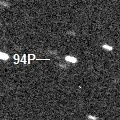
|
Now it is 17.5 mag (Jan. 13, ATLAS-HKO, Haleakala). It brightens rapidly, and it is observable at 16.5 mag in good condition in spring. It locates somewhat low in the Southern Hemisphere.
Date(TT) R.A. (2000) Decl. Delta r Elong. m1 Best Time(A, h)
Jan. 21 8 39.94 27 1.3 1.399 2.375 170 16.9 0:42 ( 0, 82)
Jan. 28 8 34.24 27 39.0 1.382 2.359 170 16.7 0:09 ( 0, 83)
|
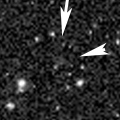
|
Now it is 16.4 mag (Jan. 1, iTelescope Observatory, Siding Spring). Very far object. It stays 16-17 mag for a long time from 2021 to 2026. In the Southern Hemisphere, it stays observable in good condition for a long time. In the Northern Hemisphere, it is not observable at all.
Date(TT) R.A. (2000) Decl. Delta r Elong. m1 Best Time(A, h)
Jan. 21 6 3.98 -76 20.4 10.532 10.436 81 16.9 21:59 ( 0,-21)
Jan. 28 5 50.07 -76 1.8 10.519 10.430 82 16.9 21:18 ( 0,-21)
|
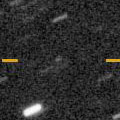
|
Appearing in the morning sky. It stays observable at 14-15 mag from spring to autumn. It locates somewhat low in the Northern Hemisphere.
Date(TT) R.A. (2000) Decl. Delta r Elong. m1 Best Time(A, h)
Jan. 21 16 58.28 -11 20.6 3.821 3.228 46 17.1 5:37 (304, 23)
Jan. 28 17 7.82 -11 48.4 3.729 3.208 51 17.0 5:34 (308, 26)
|
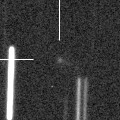
|
Now it is 17.3 mag (Jan. 11, Ken-ichi Kadota). It will brighten up to 13 mag in summer. In the Northern Hemisphere, it stays observable in good condition for a long time. In the Southern Hemisphere, it is not observable until August.
Date(TT) R.A. (2000) Decl. Delta r Elong. m1 Best Time(A, h)
Jan. 21 10 20.97 64 56.5 1.749 2.500 130 17.2 2:23 (180, 60)
Jan. 28 9 57.11 70 15.7 1.707 2.429 126 17.0 1:33 (180, 55)
|
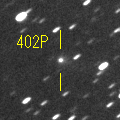
|
It brightened up to 15.3 mag in last winter (Jan. 12, 2022, H. Nohara). Now it is fading. It has already faded down to 17.0 mag (Jan. 2, Purple Mountain Observatory, XuYi Station). It will be observable at 17 mag in good condition in next winter. It locates low in the Southern Hemisphere.
Date(TT) R.A. (2000) Decl. Delta r Elong. m1 Best Time(A, h)
Jan. 21 10 21.84 24 58.2 3.658 4.532 149 17.0 2:23 ( 0, 80)
Jan. 28 10 19.16 25 53.9 3.634 4.550 155 17.0 1:53 ( 0, 81)
|

|
It brightened very rapidly up to 15.5 mag from last autumn to last winter (Nov. 2, 2021, Toshihiko Ikemura, Hirohisa Sato). Now it is fading slowly. It has already faded down to 16.8 mag (Jan. 11, ATLAS Chile).
Date(TT) R.A. (2000) Decl. Delta r Elong. m1 Best Time(A, h)
Jan. 21 6 17.04 9 28.6 3.650 4.534 150 17.1 22:15 ( 0, 64)
Jan. 28 6 14.35 9 35.7 3.723 4.555 143 17.2 21:45 ( 0, 65)
|
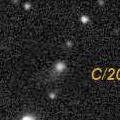
|
Now it is 17.1 mag (Jan. 3, ATLAS Chile). It stays 17 mag and observable in good condition for a long time until 2023 summer.
Date(TT) R.A. (2000) Decl. Delta r Elong. m1 Best Time(A, h)
Jan. 21 13 33.15 5 40.4 8.651 8.885 100 17.2 5:34 ( 0, 61)
Jan. 28 13 31.40 6 8.2 8.536 8.890 108 17.1 5:05 ( 0, 61)
|
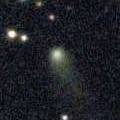
|
Now it is 17.1 mag (Dec. 14, A. Diepvens). Fading slowly. In the Southern Hemisphere, it is not observable after this.
Date(TT) R.A. (2000) Decl. Delta r Elong. m1 Best Time(A, h)
Jan. 21 17 50.28 42 39.9 6.238 5.983 70 17.2 5:37 (241, 41)
Jan. 28 17 57.71 43 36.7 6.242 6.015 72 17.2 5:34 (241, 45)
|

|
Now it is 16.5 mag (Jan. 1, ATLAS Chile). It brightened up to 14 mag from 2020 to 2021. Now it is fading slowly.
Date(TT) R.A. (2000) Decl. Delta r Elong. m1 Best Time(A, h)
Jan. 21 0 25.94 -11 48.2 4.623 4.246 61 17.2 18:45 ( 42, 33)
Jan. 28 0 30.90 -10 54.1 4.729 4.262 56 17.3 18:51 ( 49, 29)
|
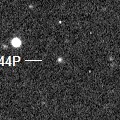
|
Now it is 17.5 mag (Jan. 18, Toshihiko Ikemura, Hirohisa Sato). It is observable at 17 mag in good condition in winter. It locates somewhat low in the Southern Hemisphere.
Date(TT) R.A. (2000) Decl. Delta r Elong. m1 Best Time(A, h)
Jan. 21 5 53.29 26 16.1 3.059 3.928 148 17.3 21:51 ( 0, 81)
Jan. 28 5 50.51 26 11.6 3.122 3.930 140 17.3 21:21 ( 0, 81)
|

|
Now it is 17.1 mag (Jan. 9, D. Buczynski). Fading slowly. In the Northern Hemisphere, it stays observable in good condition for a long time. In the Southern Hemisphere, it is not observable after this.
Date(TT) R.A. (2000) Decl. Delta r Elong. m1 Best Time(A, h)
Jan. 21 18 9.02 65 17.8 9.634 9.657 88 17.3 5:37 (211, 41)
Jan. 28 18 13.61 65 57.2 9.646 9.674 88 17.3 5:34 (209, 43)
|
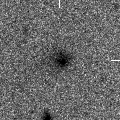
|
Now it is 17.4 mag (Jan. 9, ATLAS South Africa). Very large comet. It is expected to brighten up to 14 mag in 2031. In the Southern Hemisphere, it stays observable in good condition for a long time. In the Northern Hemisphere, it is not observable until 2030.
Date(TT) R.A. (2000) Decl. Delta r Elong. m1 Best Time(A, h)
Jan. 21 2 27.55 -60 2.6 18.310 18.077 74 17.4 18:45 ( 2, -5)
Jan. 28 2 27.64 -59 45.9 18.320 18.052 72 17.4 18:51 ( 7, -5)
|
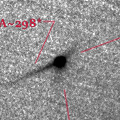
|
Due to the DART spacecraft impact to its satellite Dimorphos on Sept. 26, the cometary activity was detected. It brightened up to 12.9 mag (Sept. 28, John Drummond). It has already returned to its original brightness. It stays observable in good condition for a while.
Date(TT) R.A. (2000) Decl. Delta r Elong. m1 Best Time(A, h)
Jan. 21 7 16.77 30 50.7 0.375 1.348 163 17.5 23:14 ( 0, 86)
Jan. 28 7 12.32 30 44.2 0.427 1.387 156 18.0 22:43 ( 0, 86)
|

|
Now it is 17.4 mag (Jan. 18, Toshihiko Ikemura, Hirohisa Sato). It stays 17 mag for a long time from 2023 to 2024. It is observable in good condition in the Northern Hemisphere. It locates low in the Southern Hemisphere.
Date(TT) R.A. (2000) Decl. Delta r Elong. m1 Best Time(A, h)
Jan. 21 2 21.70 27 53.3 6.792 7.057 101 17.6 18:45 ( 38, 81)
Jan. 28 2 23.23 27 54.0 6.887 7.043 95 17.6 18:51 ( 63, 76)
|

|
It brightened up to 14 mag in 2021. Now it is fading. It has already faded down to 17.4 mag (Jan. 7, W. Hasubick). It will be fainter than 18 mag in March. It is already unobservable in the Southern Hemisphere.
Date(TT) R.A. (2000) Decl. Delta r Elong. m1 Best Time(A, h)
Jan. 21 23 27.77 16 40.3 7.241 6.816 60 17.6 18:45 ( 81, 42)
Jan. 28 23 30.77 17 4.7 7.372 6.856 55 17.7 18:51 ( 86, 36)
|

|
Now it is 17.8 mag (Dec. 26, Ken-ichi Kadota). It is observable at 17.5 mag in good condition in winter.
Date(TT) R.A. (2000) Decl. Delta r Elong. m1 Best Time(A, h)
Jan. 21 8 54.96 -0 25.1 2.571 3.497 156 17.7 0:57 ( 0, 54)
Jan. 28 8 51.47 -0 22.6 2.551 3.497 160 17.7 0:26 ( 0, 55)
|
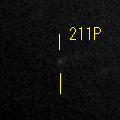
|
Now it is 18.1 mag (Dec. 30, Ken-ichi Kadota). It brightens up to 17.5 mag from January to February. It locates somewhat low in the Southern Hemisphere.
Date(TT) R.A. (2000) Decl. Delta r Elong. m1 Best Time(A, h)
Jan. 21 12 0.62 17 52.5 1.723 2.433 125 17.7 4:02 ( 0, 73)
Jan. 28 12 2.73 19 9.4 1.675 2.446 132 17.7 3:36 ( 0, 74)
|
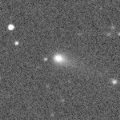
|
Now it is 17.9 mag (Dec. 25, Catalina Sky Survey). It continued brightening even after the perihelion passage. It will be fading after this, and it will be fainter than 18 mag in February.
Date(TT) R.A. (2000) Decl. Delta r Elong. m1 Best Time(A, h)
Jan. 21 23 35.65 -0 35.8 5.033 4.522 53 17.7 18:45 ( 62, 33)
Jan. 28 23 41.58 -0 1.5 5.132 4.537 48 17.8 18:51 ( 68, 29)
|
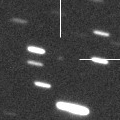
|
Now it is 17.4 mag (Dec. 29, D. Wilde). It stays 17.5 mag until spring. It is observable in good condition in the Northern Hemisphere. It is not observable in the Southern Hemisphere.
Date(TT) R.A. (2000) Decl. Delta r Elong. m1 Best Time(A, h)
Jan. 21 22 12.36 79 59.5 2.810 3.155 101 17.7 18:45 (168, 38)
Jan. 28 23 7.21 80 20.5 2.813 3.146 100 17.7 18:51 (169, 39)
|

|
It has not been observed yet in this apparition. In the last apparition, it had faded before the perihelion passage. If it becomes as bright as its last apparition, it will brighten up to 17 mag. It stays observable in good condition for a long time.
Date(TT) R.A. (2000) Decl. Delta r Elong. m1 Best Time(A, h)
Jan. 21 13 50.35 -0 5.7 2.698 2.946 94 17.9 5:37 (354, 55)
Jan. 28 13 56.52 -0 3.2 2.587 2.926 100 17.8 5:30 ( 0, 55)
|
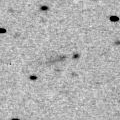
|
Now it is 18.4 mag (Dec. 18, Ken-ichi Kadota). It stays observable at 18 mag in good condition from January to March.
Date(TT) R.A. (2000) Decl. Delta r Elong. m1 Best Time(A, h)
Jan. 21 10 33.53 12 35.7 3.367 4.210 144 17.9 2:35 ( 0, 67)
Jan. 28 10 31.53 12 58.9 3.307 4.206 152 17.8 2:05 ( 0, 68)
|

|
It brightened up to 12.3 mag from spring to summer in 2021 (June 15, 2021, Marco Goiato). Now it is fading. It has already faded down to 17.7 mag (Jan. 2, J. Jahn). It will be fainter than 18 mag in January.
Date(TT) R.A. (2000) Decl. Delta r Elong. m1 Best Time(A, h)
Jan. 21 12 35.26 39 17.4 5.947 6.504 120 17.9 4:36 (180, 86)
Jan. 28 12 31.07 40 31.1 5.923 6.551 126 18.0 4:05 (180, 85)
|
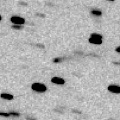
|
Now it is 17.9 mag (Dec. 27, Ken-ichi Kadota). In the Northern Hemisphere, it stays observable at 17 mag in good condition for a long time until winter. In the Southern Hemisphere, it stays extremely low for a long time.
Date(TT) R.A. (2000) Decl. Delta r Elong. m1 Best Time(A, h)
Jan. 21 7 48.76 50 15.9 2.330 3.217 149 17.9 23:47 (180, 75)
Jan. 28 7 43.40 49 38.1 2.383 3.252 146 18.1 23:14 (180, 75)
|
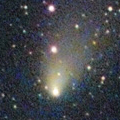
|
It brightened up to 10.4 mag from June to July (July 22, Ken-ichi Kadota). Now it is fading. Appearing in the morning sky in the Souther Hemisphere. It was originally predicted as 15 mag now. But actually, now it is very faint as 18.4 mag (Jan. 2, Martin Masek). It will never be observable again in the Northern Hemisphere.
Date(TT) R.A. (2000) Decl. Delta r Elong. m1 Best Time(A, h)
Jan. 21 19 35.20 -64 46.3 3.359 2.754 45 18.9 5:37 (330,-31)
Jan. 28 20 1.33 -64 26.3 3.420 2.833 46 19.2 5:34 (330,-31)
|
|
![]()
 77P/Longmore
77P/Longmore C/2021 G2 ( ATLAS )
C/2021 G2 ( ATLAS ) 117P/Helin-Roman-Alu 1
117P/Helin-Roman-Alu 1 119P/Parker-Hartley
119P/Parker-Hartley C/2020 S4 ( PanSTARRS )
C/2020 S4 ( PanSTARRS ) C/2020 Y2 ( ATLAS )
C/2020 Y2 ( ATLAS ) 61P/Shajn-Schaldach
61P/Shajn-Schaldach 204P/LINEAR-NEAT
204P/LINEAR-NEAT C/2022 E2 ( ATLAS )
C/2022 E2 ( ATLAS ) 285P/LINEAR
285P/LINEAR P/2022 L3 ( ATLAS )
P/2022 L3 ( ATLAS ) 116P/Wild 4
116P/Wild 4 C/2018 U1 ( Lemmon )
C/2018 U1 ( Lemmon ) C/2021 C5 ( PanSTARRS )
C/2021 C5 ( PanSTARRS ) C/2022 A3 ( Lemmon-ATLAS )
C/2022 A3 ( Lemmon-ATLAS ) 408P/2020 M7 ( Novichonok-Gerke )
408P/2020 M7 ( Novichonok-Gerke ) C/2022 L2 ( ATLAS )
C/2022 L2 ( ATLAS ) 263P/Gibbs
263P/Gibbs 94P/Russell 4
94P/Russell 4 C/2019 E3 ( ATLAS )
C/2019 E3 ( ATLAS ) 199P/Shoemaker 4
199P/Shoemaker 4 C/2022 W3 ( Leonard )
C/2022 W3 ( Leonard ) 402P/2020 Q3 ( LINEAR )
402P/2020 Q3 ( LINEAR ) P/2021 N2 ( Fuls )
P/2021 N2 ( Fuls ) C/2020 F2 ( ATLAS )
C/2020 F2 ( ATLAS ) C/2020 H6 ( ATLAS )
C/2020 H6 ( ATLAS ) 246P/NEAT
246P/NEAT 244P/Scotti
244P/Scotti C/2019 O3 ( Palomar )
C/2019 O3 ( Palomar ) C/2014 UN271 ( Bernardinelli-Bernstein )
C/2014 UN271 ( Bernardinelli-Bernstein ) (65803) Didymos
(65803) Didymos C/2021 S4 ( Tsuchinshan )
C/2021 S4 ( Tsuchinshan ) C/2020 F5 ( MASTER )
C/2020 F5 ( MASTER ) P/2021 V2 ( Fuls )
P/2021 V2 ( Fuls ) 211P/Hill
211P/Hill 395P/2020 H1 ( Catalina-NEAT )
395P/2020 H1 ( Catalina-NEAT ) C/2022 W2 ( ATLAS )
C/2022 W2 ( ATLAS ) 280P/Larsen
280P/Larsen 452P/2022 B5 ( Sheppard-Jewitt )
452P/2022 B5 ( Sheppard-Jewitt ) C/2020 J1 ( SONEAR )
C/2020 J1 ( SONEAR ) C/2021 QM45 ( PanSTARRS )
C/2021 QM45 ( PanSTARRS ) C/2021 P4 ( ATLAS )
C/2021 P4 ( ATLAS )![]()






























































